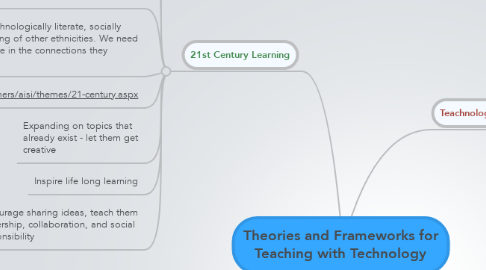
1. SAMR
1.1. Substitution
1.1.1. Substituting or swapping one tool for another to create the same outcome. Example: asking students to submit their paper via email rather than handing it in on paper. There is no functional change.
1.2. Augmentation
1.2.1. One step up from Substitution, Augmentation offers more immediate feedback such as peer marking, or online quizzes. Even though students are still working towards normal assignments there is a functional benefit in the amount of engagement each student offers to the task.
1.3. Modification
1.3.1. Taking a task and beginning to transform it into a much more engaged performance. Recorded oral presentations in a second language, with an oral question and answer involving classmates is a representation of this. We can delve one level deeper than before and it is no longer just the teacher viewing the students, so personal and social integrity becomes involved. Significant functional benefit.
1.4. Redefinition
1.4.1. Sharing the videos on youtube or google docs with another class learning the opposite language. The other students could offer pointers on how to sound more authentic to the other party. Now we have gotten mother tongue students involved and opened the doors to real life application. Entire transformation and huge benefit to students.
2. 21st Century Learning
2.1. we need to teach curiousness and show that the ability to question people is a positive
2.2. Getting them to grasp the content, but also to teach them how to reproduce that information like I am doing now involving this topic
2.3. Teach them to be reflective and critical of themselves
2.4. Teach them to be technologically literate, socially adaptive and accepting of other ethnicities. We need to create a confidence in the connections they establish.
2.5. http://education.alberta.ca/teachers/aisi/themes/21-century.aspx
2.6. Expanding on topics that already exist - let them get creative
2.7. Inspire life long learning
2.8. Encourage sharing ideas, teach them leadership, collaboration, and social responsibility
3. TPACK
3.1. Technological Knowledge (TK)
3.1.1. Skills required to operate computer hardware, software, including installing and deleting, creating archive documents, and etc.
3.2. Pedagogical Knowledge (PK)
3.2.1. Knowledge about teaching in learning. How students form schemas and habits related to learning. How to tackle lesson plans, assessment, classroom management, and strategies involving students with learning blocks.
3.3. Content Knowledge (CK)
3.3.1. Teachers must have deep knowledge of the subjects they are teaching. Including theories, concepts, and the nature of the knowledge. An example being math vs. language.
3.4. Technological Content Knowledge (TCK)
3.4.1. The use of tools and how content may be represented or changed by the use of technology
3.5. Pedagogical Content Knowledge (PCK)
3.5.1. What teaching approaches fit the content. How the content can be arranged for better representation of concepts. Better representation creates better learning and can tackle areas of difficulty concerning more advanced or complex topics in the subject's content.
3.6. Technological Pedagogical Knowledge (TPK)
3.6.1. How a teacher can use technological tools to assist with the engagement of students, classroom management such as attendance but also, how certain pedagogical concepts may change as the integration of technology becomes more relevant.

